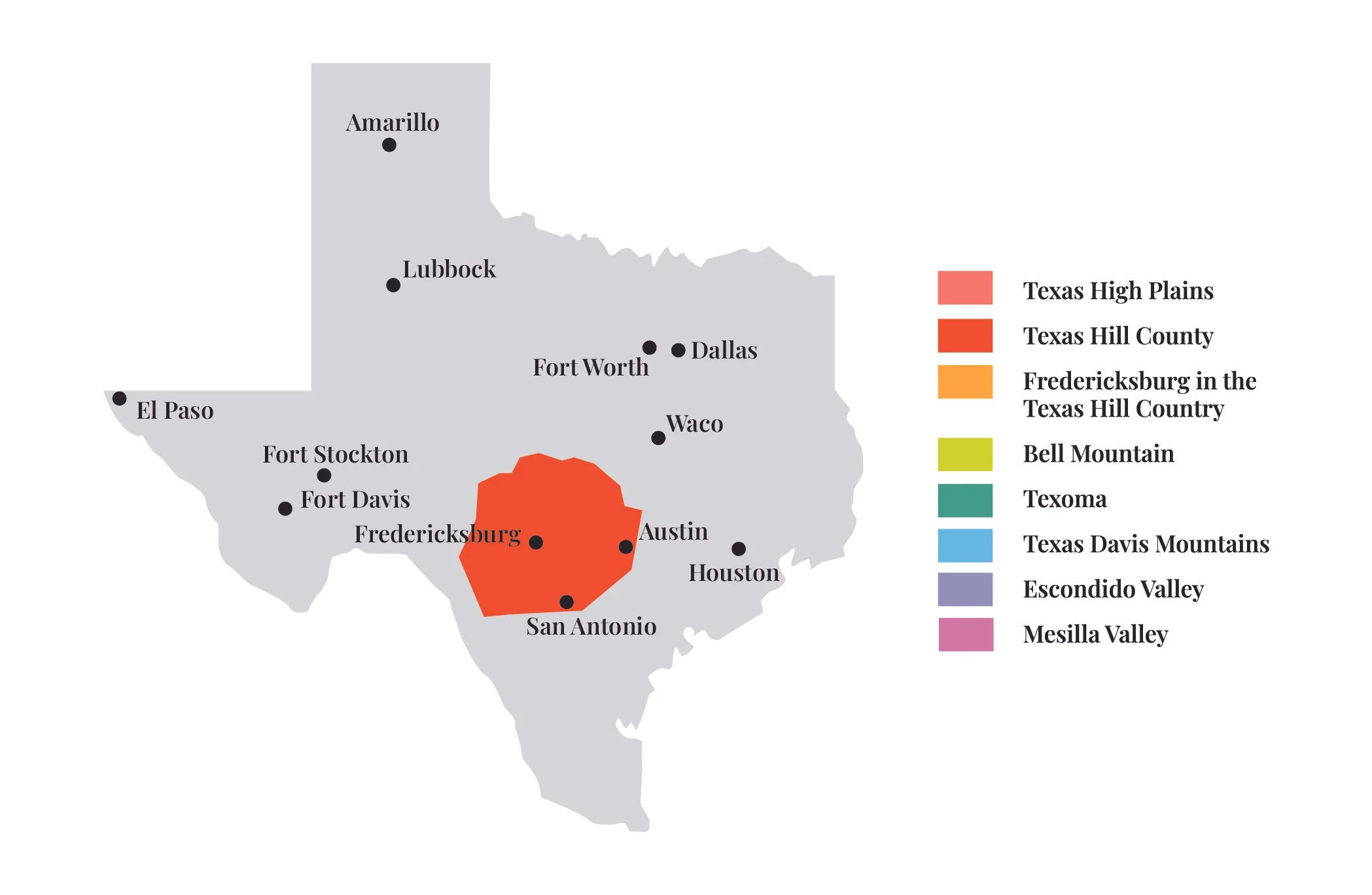Texas Hill Country AVA
Limestone, Live Oaks & Legendary Hospitality
Rolling hills dappled with live oaks, spring‑fed creeks, and fields of bluebonnets set the scene for the Texas Hill Country American Viticultural Area (AVA). Established in 1991, it spans nearly 9 million acres across Central Texas, making it one of the largest AVAs in the United States. While most visitors come for ghost towns and swimming holes, more than 100 wineries now form a vibrant wine‑tourism corridor less than an hour from Austin or San Antonio. For beginning wine students, the Hill Country offers a textbook example of how limestone soils, elevation, and a subtropical climate combine to shape Mediterranean‑style wines with Texas flair.
Location & Landscape
The AVA stretches roughly 140 miles north–south and 100 miles east–west, anchored by the towns of Fredericksburg, Johnson City, Stonewall, and Hye along U.S. Highway 290. Elevations rise from 1,000 to 2,400 feet, moderating summer heat and giving vines a daily respite as nighttime temperatures dip 20 °F or more. Two distinct geologic zones dominate:
• Edwards Plateau (limestone) - east of Fredericksburg, where shallow clay loams over fractured limestone yield bright, mineral‑driven whites.
• Llano Uplift (granite & gneiss) - around Llano and Pontotoc, whose rocky, well‑drained soils encourage deep root penetration and concentrated red‑fruit flavors in Rhône varieties.
Climate: Warm Days, Cool Nights & Flash Rains
· Rainfall: 26‑32 inches annually—double the High Plains—but delivered in intense spring downpours; growers rely on well‑drained slopes and vigilant canopy work to prevent rot.
· Humidity: Higher than West Texas, so fungal pressure is real; many vineyards orient rows to catch prevailing southerly breezes for fast drying.
· Diurnal Range: Elevation drops nighttime temps by 20‑25 °F, preserving acidity and color.
· Heat Units: Comparable to Tuscany or southern Rhône; early budbreak can expose vines to April frost, so wind machines and burn barrels are common sights.
The Hill Country’s blend of warmth and limestone distinguishes it from cooler Old‑World benchmarks. Expect ripe fruit wrapped in a savory, mineral backbone.
Terroir: Limestone & Granite Under Foot
Most vineyards sit on shallow, alkaline clay loams overlaying limestone bedrock—soil that reflects sunlight, stores daytime heat, and releases it overnight, helping tannins ripen. In the north‑western Hill Country, the Llano Uplift’s pink granite and sandy soils boost drainage, stressing vines just enough to craft small, intensely flavored berries. These calcareous and granitic soils also raise wine pH more slowly than heavier clays, keeping acids lively even in hot vintages.
Signature Grapes & Why They Thrive
Tempranillo - Early budding but thick‑skinned; limestone soils and hot days mimic Spain’s Ribera del Duero.
Tannat - Thrives in heat; high tannin polymerizes gently thanks to warm nights and extended hang‑time.
Mourvèdre - Late‑ripening grape loves long Hill Country falls; granite soils intensify wild herb aromas.
Viognier - Aromatic variety needs warmth; limestone retains enough water to prevent sunburn on tight clusters.
Sangiovese - Adapts to calcareous clay; elevation preserves cherry acidity reminiscent of Tuscan classics.
Aglianico & Picpoul - Mediterranean natives showing promise as growers chase heat‑tolerant alternatives.
More than 50 grape varieties are under vine, but wine educators emphasize Mediterranean cultivars—they handle Texas heat better than cool‑climate stars like Pinot Noir.
Interesting Facts
· Second‑Most Visited U.S. Wine Region: Only Napa Valley draws more annual tasting‑room visitors, thanks to Austin‑San Antonio day‑trippers.
· Wine Road 290: A 30‑mile stretch between Johnson City and Fredericksburg packs over 40 wineries—ideal for comparative tasting.
· Wildflower Vintage: Bluebonnets blanket vineyard floors each April, reducing erosion and attracting beneficial insects.
· German Heritage: Fredericksburg’s 19th‑century settlers left a legacy of sausage, sauerkraut, and dry Riesling that still pairs perfectly with local Viognier.
Visiting & Nearby Cities
• Austin – 45 minutes east via U.S. 290
• San Antonio – 1 hour south via U.S. 281/I‑10
• Fredericksburg – Heart of Hill Country tasting rooms
• San Marcos & New Braunfels – Gateway towns with river tubing and German bakeries
Tasting itineraries often start on Wine Road 290, then branch onto scenic ranch roads toward Johnson City, Hye, and Willow City Loop.
Putting It All Together
Hill Country AVA teaches two essential lessons:
· Limestone is a winemaker’s friend. It reflects heat, moderates acids, and imparts a stony backbone distinct from sandy soils.
· Right grape, right place. Mediterranean varieties—Tempranillo, Mourvèdre, Tannat—outshine classic Bordeaux clones in Texas heat.
Next time you swirl a Hill Country Tempranillo and catch notes of red cherry, cedar, and dusty limestone, remember: those flavors were forged by Texas hilltops kissed by sun and cooled by night‑time breezes.

